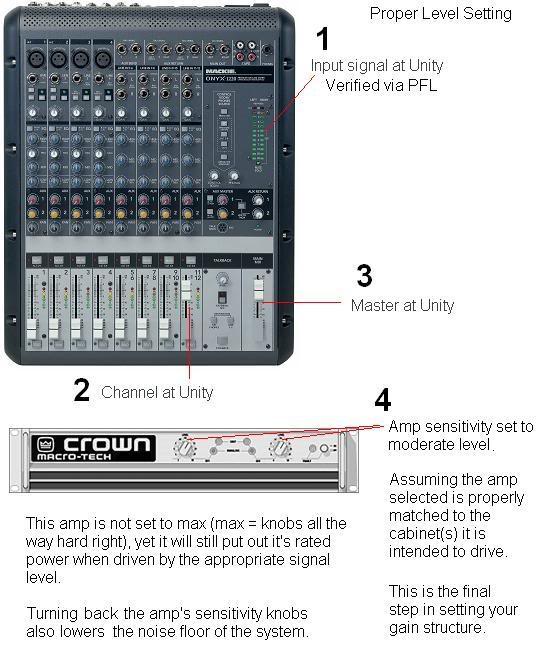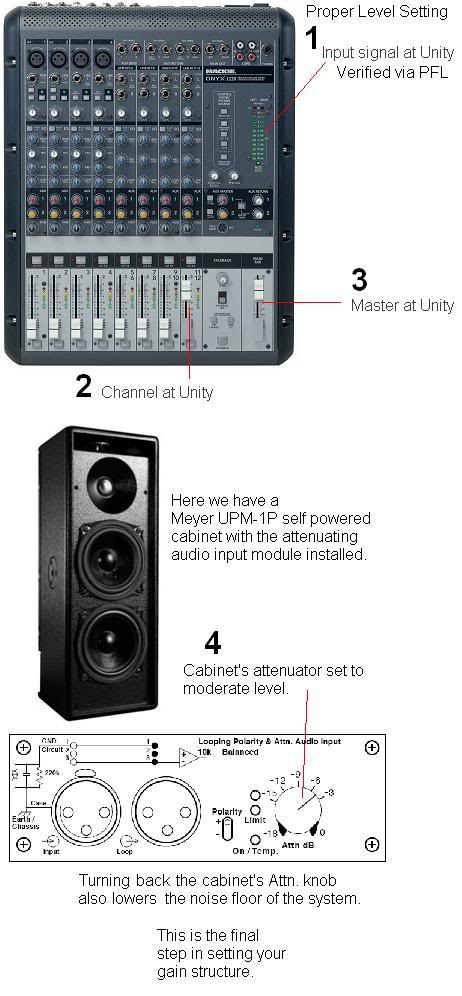I'm investigate the requirements to upgrade our church monitors. We currently have an acoustic guitar, keyboard, piano, organ, drum set, three backup vocalists and lead vocalists. All of which are supported by one monitor feed (Guitar, organ and drums are not included in feed).
My biggest hangup is our cable snake is maxed out and I don't know if I should use the 1/4" sends (Which say do not use to power speakers) or if I need to purchase a special cable.
I plan on employing 3 monitor sends. 2 of which will go to an amp and then to floor wedges and the 3rd will run to a galaxy powered hotspot that will be daisy chained to 2 unpowered galaxy hot spots.
Can I use the current sends or do I need special cables. Btw, the mixer is about 125 foot from the stage.
Comments
Also, whatever device is driving the monitor feed(s)-is it the m
Also, whatever device is driving the monitor feed(s)-is it the mixer directly, or a graphic equalizer after the mixer,or...? Is that signal you are going to send down the snake balanced or unbalanced?
Bent, correct me if I'm wrong about this, but if the device's output is unbalanced, and goes through the balanced connections on the snake, he's still open to problems running a cable that long, no?
I don't think most professional snakes would have any unbalanced
I don't think most professional snakes would have any unbalanced lines, I would hope it's TRS.
Since it's such a long run I would think that maybe it would be a good idea to invest in a second board for the monitors and have someone run them from the side of the stage. You would need a splitter for the mics, it would be like having another sound system and a person to run it. But if you have the assets in money and someone who you can teach than that would be the best way.
To have a signal go all the way there and back does not make for good sound quality. But it's better to have a long run on that then speakers. Speaker cables should be as short as possible. Line level amplifiers can be used to increase gain, if they are of good quality the sound should be alright. But you must have a balanced signal to run at that length other wise the noise and sound quality will be unacceptable.
Having to control 3 sends along with the front system is too much for someone 100 feet away. The people on the stage will be going crazy and they will complain to no end, trust me on that.
I'm not a fan of those hot spots. I did a band that used them and the quality was terrible. I would into having another system on the stage run by a soundman on the side of the stage somewhere. In the long run it is the best way to do it.
A 3 zone system would be easy to build and would make everybody happy. A few inexpensive EQ's, compressors and a way to power the speakers.
bent wrote: Yes, the ring will be ignored. But, and you can corr
bent wrote: Yes, the ring will be ignored.
But, and you can correct me here. He could use a DI to balance it, if that's the case, couldn't he?
A DI with an XLR(F) to 1/4" TRS(F) adapter on the DI's XLR(M) output.
I would try to avoid using a conventional DI box here. The operating level most are designed for is much lower than what most line level devices can belt out. Aphex makes a small line distribution/balancing amp (model 120A) that I've seen on e-Bay several times. If this church needs to drive a long signal through the snake, and their current gear is questionable, this will help do the trick. It has 4 channels- 3 foldbacks and the house- how cool is that!
I have come to grips with the fact that HotSpots are a necessary evil in smaller church sound. They love 'em. I sure don't. They do tend to keep the "wash" down to a minimum. They just suck at sounding decent. 3 things to watch out for:
1) The passive models with the VC (volume control) option jump to 96 ohms- YIKES!!!- if you back them off even one "step" from "full on". This can wreak havoc on your power amp. Which brings us to...
2) The active models' power amp is pretty whimpy and sensitive to loads.
They heat up under hard loads. Especially if program material other than just vocals is pumped into them, Which brings up ...
3) Try to keep any material lower than 200 Hz. OUT of those things. This may seem obvious, but if the talent using them has you put stuff like keys, drums, etc. into them, the little drivers in those HS's can't handle it.
They "bottom out" and sound even worse, plus they'll heat up faster. Comes in handy if you're fryin' eggs, but...
Have a look under the floor? Maybe they're hiding and weren't pu
Have a look under the floor? Maybe they're hiding and weren't pulled up along with the sends? Or they could just be nonexistent.
Come to think of it, our snake's returns...the installation guy cut off the XLR ends and wired 1/4" TS (I think) connectors to 3 of them.
bigdaddybluesman:
"Having to control 3 sends along with the front system is too much for someone 100 feet away."
I do this sort of thing in our Church. 2 aux plus front of house. At a concert coming up soon, I'm going to use spare Aux buses etc. to record 5/6 separate channels (including a split vox monitor) of the gig. I make that 2 aux, FoH, 4 further aux/efx channels, split across 2 devices.
You get used to it :D.
Church sound guys do get it bad. I mean, our speakers run off the board amp, with about 60' of cable to them. It's run under the floor with the snake, projector feed AND extension cord to power the setup on our "desk" which is less stable than a one-legged horse.
Nothing works either, the amp for our induction loop randomly goes haywire (every week), seems to overload itself (gauge reads max) and the amp itself squeals audibly from 50' away. What the hearing aid users hear, I can only pray it's not loud.
Oh yeah, and in our band, everyone sings lead. 6 lead vox, a piano/organ with it's own 1.21gigawatt speaker system built in...
Actually, not yet. The problem's kinda melted into nothing. Usin
Actually, not yet. The problem's kinda melted into nothing. Using our sole DI box on the violin as opposed to the piano helps though.
Sometime this year we're stripping out the pews, putting in seats, and moving our desk forward by almost 10 feet. When we do, I'll see to it that the extension powering the desk is brought from elsewhere. Right now it comes out the same hole as the snake, you know...
I was in another Church for an evening service on Sunday there. The hall is about 40' long in total and they have a smallish sound system in. The hissing/humming was audible as soon as things got close to quiet. During the prayers, all I was thinking was "ground loop, ground loop"...and I've decided that ours is negligible in comparison.
Keep in mind also that when you run amps wide open (and this hol
Keep in mind also that when you run amps wide open (and this holds true on powered speakers such as JBL Eons, UPA's, MSL's, etc.) you are amplifying the noise floor. I say this not assuming you are doing this, but I see folks running their amps wide open all the time - boosting the noise floor and obliterating their headroom.
I should have told you this sooner, sorry.
The best way to set up your PA system is to set unity gain at the console first before you turn up your amps. An easy way to do this, before you even touch the amp(s), is to play a CD through two channels (or one stereo, if you're so inclined), set it's peaks at unity via PFL, push the master faders up to unity, then turn up the amps.
I don't think you have the ability to do this at your church with the console you have - but it's good food for thought...
Following this advice, no matter where you're mixing (even in the studio), you'll be surprised at just how loud that old amp you thought was junk can be!
If you are not mixing at unity, taking advantage of the fact that most consoles have 24dB+ of headroom (that's 24dB above the unity notches on the master faders), there is something wrong with the gain structure of the system - overpowered cabinets force you to keep your masters down below unity and the noise floor at an audible level, underpowering causes you to push the masters to the max, which brings the noise floor of the console into the mix, not to mention the distortion the amps will see from the console driving into clip!
"the unity notches on the master faders" Heh...ours doesn't have
"the unity notches on the master faders"
Heh...ours doesn't have notches. It just slides right past the 0 mark.
Every time I come onto this site I learn something new. What is "running an amp wide open"? Running it at full and maxing it?
We have a practice tonight so I'll play about with things. Stupidly, I usually have the master volume at about -20 which is loud enough during practices...but come to think of it, the congregation does drown the speakers out a bit. I'll have that yellow 0/+3 dB led lit tonight. Only problem is I'll hear the speakers slicing through my headphones (but, as I just said in another post, by Thursday I'll have some Sennheiser HD280s :D).
Only thing with doing that is that the buzzing will likely get more prominent. Feedback isn't a worry since the only risk is the monitors, one of which is miles from any mikes.
Aha...thanks for clearing that up. Having a 1280x960 screen make
Aha...thanks for clearing that up.
Having a 1280x960 screen makes the first pic look kinda thin actually. :P
Now I see that the monitor amp needs to come down a bit. It's a 90W driving 300W cabs, which is somehow loud enough but hisses a lot, which I found out tonight. Also found out that the returns on the snake have thankfully had TRS connectors put on them in place of the XLRs, small mercies, eh?






Can I use the current sends? Yes. When they say "do not use t
Yes.
When they say "do not use to power speakers" what they mean is you should not use it as a speaker cable (between the amp and cabinet).
If you are going to use it as a return line from your auxes to the amp rack you are golden!
One question - are the 1/4" return lines balanced?
125' is a long way to run an unbalanced signal.